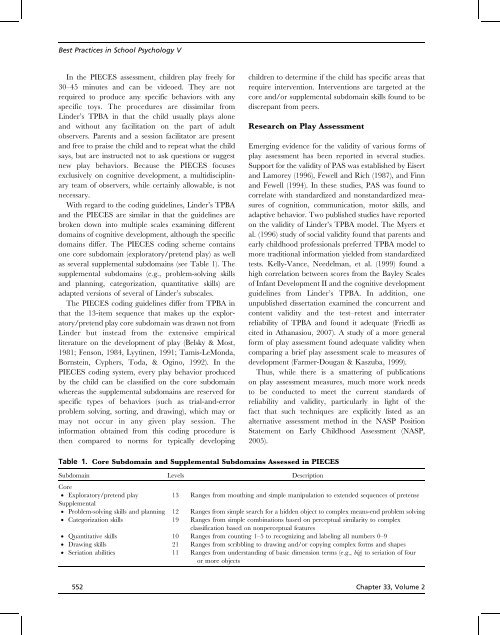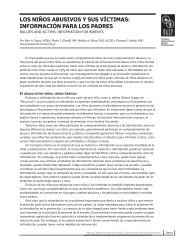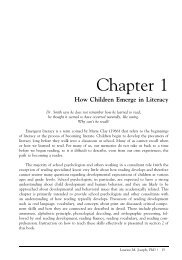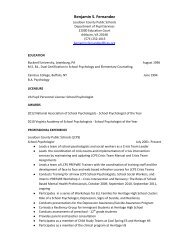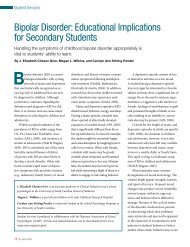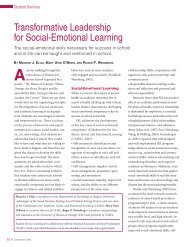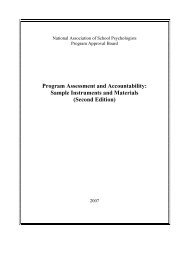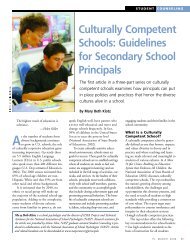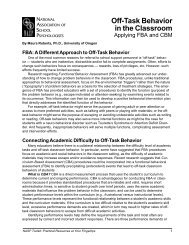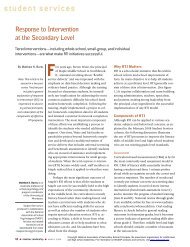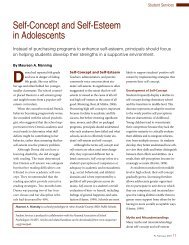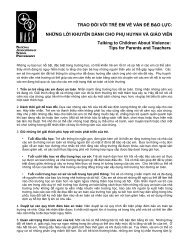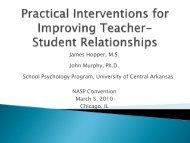Best Practices in Play Assessment and Intervention
Best Practices in Play Assessment and Intervention
Best Practices in Play Assessment and Intervention
Create successful ePaper yourself
Turn your PDF publications into a flip-book with our unique Google optimized e-Paper software.
<strong>Best</strong> <strong>Practices</strong> <strong>in</strong> School Psychology V<br />
In the PIECES assessment, children play freely for<br />
30–45 m<strong>in</strong>utes <strong>and</strong> can be videoed. They are not<br />
required to produce any specific behaviors with any<br />
specific toys. The procedures are dissimilar from<br />
L<strong>in</strong>der’s TPBA <strong>in</strong> that the child usually plays alone<br />
<strong>and</strong> without any facilitation on the part of adult<br />
observers. Parents <strong>and</strong> a session facilitator are present<br />
<strong>and</strong> free to praise the child <strong>and</strong> to repeat what the child<br />
says, but are <strong>in</strong>structed not to ask questions or suggest<br />
new play behaviors. Because the PIECES focuses<br />
exclusively on cognitive development, a multidiscipl<strong>in</strong>ary<br />
team of observers, while certa<strong>in</strong>ly allowable, is not<br />
necessary.<br />
With regard to the cod<strong>in</strong>g guidel<strong>in</strong>es, L<strong>in</strong>der’s TPBA<br />
<strong>and</strong> the PIECES are similar <strong>in</strong> that the guidel<strong>in</strong>es are<br />
broken down <strong>in</strong>to multiple scales exam<strong>in</strong><strong>in</strong>g different<br />
doma<strong>in</strong>s of cognitive development, although the specific<br />
doma<strong>in</strong>s differ. The PIECES cod<strong>in</strong>g scheme conta<strong>in</strong>s<br />
one core subdoma<strong>in</strong> (exploratory/pretend play) as well<br />
as several supplemental subdoma<strong>in</strong>s (see Table 1). The<br />
supplemental subdoma<strong>in</strong>s (e.g., problem-solv<strong>in</strong>g skills<br />
<strong>and</strong> plann<strong>in</strong>g, categorization, quantitative skills) are<br />
adapted versions of several of L<strong>in</strong>der’s subscales.<br />
The PIECES cod<strong>in</strong>g guidel<strong>in</strong>es differ from TPBA <strong>in</strong><br />
that the 13-item sequence that makes up the exploratory/pretend<br />
play core subdoma<strong>in</strong> was drawn not from<br />
L<strong>in</strong>der but <strong>in</strong>stead from the extensive empirical<br />
literature on the development of play (Belsky & Most,<br />
1981; Fenson, 1984, Lyyt<strong>in</strong>en, 1991; Tamis-LeMonda,<br />
Bornste<strong>in</strong>, Cyphers, Toda, & Og<strong>in</strong>o, 1992). In the<br />
PIECES cod<strong>in</strong>g system, every play behavior produced<br />
by the child can be classified on the core subdoma<strong>in</strong><br />
whereas the supplemental subdoma<strong>in</strong>s are reserved for<br />
specific types of behaviors (such as trial-<strong>and</strong>-error<br />
problem solv<strong>in</strong>g, sort<strong>in</strong>g, <strong>and</strong> draw<strong>in</strong>g), which may or<br />
may not occur <strong>in</strong> any given play session. The<br />
<strong>in</strong>formation obta<strong>in</strong>ed from this cod<strong>in</strong>g procedure is<br />
then compared to norms for typically develop<strong>in</strong>g<br />
children to determ<strong>in</strong>e if the child has specific areas that<br />
require <strong>in</strong>tervention. <strong>Intervention</strong>s are targeted at the<br />
core <strong>and</strong>/or supplemental subdoma<strong>in</strong> skills found to be<br />
discrepant from peers.<br />
Research on <strong>Play</strong> <strong>Assessment</strong><br />
Emerg<strong>in</strong>g evidence for the validity of various forms of<br />
play assessment has been reported <strong>in</strong> several studies.<br />
Support for the validity of PAS was established by Eisert<br />
<strong>and</strong> Lamorey (1996), Fewell <strong>and</strong> Rich (1987), <strong>and</strong> F<strong>in</strong>n<br />
<strong>and</strong> Fewell (1994). In these studies, PAS was found to<br />
correlate with st<strong>and</strong>ardized <strong>and</strong> nonst<strong>and</strong>ardized measures<br />
of cognition, communication, motor skills, <strong>and</strong><br />
adaptive behavior. Two published studies have reported<br />
on the validity of L<strong>in</strong>der’s TPBA model. The Myers et<br />
al. (1996) study of social validity found that parents <strong>and</strong><br />
early childhood professionals preferred TPBA model to<br />
more traditional <strong>in</strong>formation yielded from st<strong>and</strong>ardized<br />
tests. Kelly-Vance, Needelman, et al. (1999) found a<br />
high correlation between scores from the Bayley Scales<br />
of Infant Development II <strong>and</strong> the cognitive development<br />
guidel<strong>in</strong>es from L<strong>in</strong>der’s TPBA. In addition, one<br />
unpublished dissertation exam<strong>in</strong>ed the concurrent <strong>and</strong><br />
content validity <strong>and</strong> the test–retest <strong>and</strong> <strong>in</strong>terrater<br />
reliability of TPBA <strong>and</strong> found it adequate (Friedli as<br />
cited <strong>in</strong> Athanasiou, 2007). A study of a more general<br />
form of play assessment found adequate validity when<br />
compar<strong>in</strong>g a brief play assessment scale to measures of<br />
development (Farmer-Dougan & Kaszuba, 1999).<br />
Thus, while there is a smatter<strong>in</strong>g of publications<br />
on play assessment measures, much more work needs<br />
to be conducted to meet the current st<strong>and</strong>ards of<br />
reliability <strong>and</strong> validity, particularly <strong>in</strong> light of the<br />
fact that such techniques are explicitly listed as an<br />
alternative assessment method <strong>in</strong> the NASP Position<br />
Statement on Early Childhood <strong>Assessment</strong> (NASP,<br />
2005).<br />
Table 1. Core Subdoma<strong>in</strong> <strong>and</strong> Supplemental Subdoma<strong>in</strong>s Assessed <strong>in</strong> PIECES<br />
Subdoma<strong>in</strong> Levels Description<br />
Core<br />
. Exploratory/pretend play 13 Ranges from mouth<strong>in</strong>g <strong>and</strong> simple manipulation to extended sequences of pretense<br />
Supplemental<br />
. Problem-solv<strong>in</strong>g skills <strong>and</strong> plann<strong>in</strong>g 12 Ranges from simple search for a hidden object to complex means-end problem solv<strong>in</strong>g<br />
. Categorization skills 19 Ranges from simple comb<strong>in</strong>ations based on perceptual similarity to complex<br />
classification based on nonperceptual features<br />
. Quantitative skills 10 Ranges from count<strong>in</strong>g 1–5 to recogniz<strong>in</strong>g <strong>and</strong> label<strong>in</strong>g all numbers 0–9<br />
. Draw<strong>in</strong>g skills 21 Ranges from scribbl<strong>in</strong>g to draw<strong>in</strong>g <strong>and</strong>/or copy<strong>in</strong>g complex forms <strong>and</strong> shapes<br />
. Seriation abilities 11 Ranges from underst<strong>and</strong><strong>in</strong>g of basic dimension terms (e.g., big) to seriation of four<br />
or more objects<br />
552 Chapter 33, Volume 2


